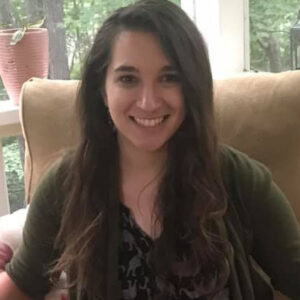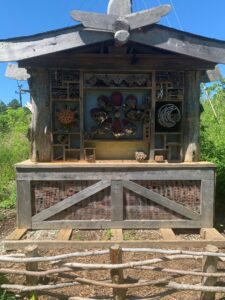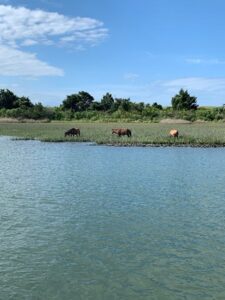
About Me
Wow! It’s hard to believe that my practicum started 3 weeks ago. The planning stages of identifying professional development goals, filling out documentation, and coordinating the requirements for my dual Master of Public Health and Master of Social Work degree have been quite a process, so it’s difficult to believe that I am already this far into my practicum!
Over the past few weeks, I have been reflecting on my previous work and extracurricular experiences and how they translate to my practicum. Before beginning my MPH at UNC Gillings, I worked as a graduate student intern at UNC Refugee Wellness (UNCRW) in the School of Social Work, and as an Anti-Human Trafficking Community Educator in Cincinnati.
Each of these roles allowed me to work in a direct service capacity and community education in the respective area. While working with UNCRW I engaged with practitioners across North Carolina to expand access to free, culturally attuned mental health resources to counties in Charlotte, Greensboro, and Ashville and used cognitive behavioral therapy techniques to provide therapy to refugees in these areas.

Working at UNCRW was an excellent experience that taught me soft skills about cultural humility and advocacy. Similarly, my work with survivors of human trafficking and sexual assault has informed my practicum experience by creating a foundational understanding of sexual assault advocacy and health work. As an Anti-Human Trafficking Community Educator, I created monthly newsletters, co-authored reports for local policymakers, and assisted with direct outreach and referral coordination.
In addition to these professional roles, I have also had the opportunity to learn from my social work professors and community partners about Art Therapy as a modality. I was introduced to art therapy through a workshop my professor, Laurie Seltz-Campbell, facilitated last year and was so captivated by how different senses (visual, auditory, touch, etc) are underutilized in the therapeutic process and how they can teach us different things about experiences. After the workshop, I signed up for an Art Therapy for Practitioner series with the Art Therapy Institute in Carrboro. These workshops were wonderful in teaching different art therapy techniques including soul collage and watercolor techniques, and I feel like they have been pivotal in getting me grounded in my practicum experience.
Sisonke Ntwana
For my practicum I am working with, Dr. Abigail Hatcher, and her research project Sisonke Ntwana, which is aimed at providing arts and play-based therapeutic interventions for pregnant and postpartum adolescents in Johannesburg. The project is a partnership with the UNC School of Public Health and The University of Witwatersrand School of Public Health in Johannesburg, so I am working alongside UNC faculty and wonderful folks who are based in South Africa.
This is a critical health issue in South Africa since nearly one in five young women will have a child as an adolescent, and these young women are often exposed to violence from family or partners and are at high risk of HIV acquisition (Hatcher, Woolett, 2021).
The study uses a developmental perspective, relying on psychological, biological, and social changes. With my background in social work, this is especially fascinating and important because it provides a critical perspective to look at how the life stage intersects with exposure to violence and mental health, and how adolescence can be a window of opportunity for intervention (Hatcher, Woolett, 2021).
To examine this, the study has three main aims:
Aim 1: Characterize violence, mental health, and HIV treatment adherence among adolescent pregnant women
Aim 2: Explore Social and Psychological Drivers of HIV adherence
Aim 3: Develop an Intervention for adolescent mental health, safe relationships, and maternal sensitivity

As an arts-based intervention working with adolescents, there are a variety of approaches that are used during a six-session therapeutic process. The sessions are a mix of individual and group therapy and include sand-tray therapy, art collage, mindful self-regulation, body mapping, storytelling, and letter writing.
As a practicum student, my role is to assist with qualitative research of these therapy sessions by identifying themes in individual sessions and group sessions and then working in Dedoose to further analyze and evaluate themes. To do this, there is a transcription and recording of each session and pictures of the artwork that is produced by clients. It is so interesting to look at the artwork while listening to descriptions. For this entire process, I keep thinking about our 701 course and ethical storytelling; since these sessions are so personal and I am in the role of identifying themes I want to do my best to make sure I am honoring people’s stories throughout this process. I am mirroring words and phrases that people use throughout and lifting them in the ways that I can.
So far, I have been working with transcriptions and recordings of therapeutic interviews and identified key themes in 23 of them. Most of the recordings are in English but a few are in Zulu and are translated to English via transcriptions. I find that listening to the recording and reading the transcription helps me connect to the program- especially for sessions in Zulu.

In addition to this, I am developing an interview guide for the arts-based therapists to reflect on their facilitation process, overall findings, and approach. There are four arts-based therapists all with different personal and professional backgrounds, so exploring their approach to therapeutic facilitation, skills, and findings will be extremely informative to qualitative research and the overall process of the intervention. As of right now, I have formed a few questions to include in the interview guide and have set up meetings with the person who oversees the therapy team to explore what type of questions will be most helpful. I am especially excited about this project because I think it will provide fascinating insights into art therapy and how we show up in the work that we do.
My goals with the practicum have been to further my research experience and learn more deeply about art therapy, so this project is a wonderful fit for me. Moreover, an unexpected benefit of the practicum has been the team I am working with and learning about a new area.
It has been amazing to get to know the project team via zoom and learn about health systems in South Africa. I’ve had several conversations with my preceptors about challenges to the health systems, some of which are like challenges in the U.S and some of which are different. We have only had 2 group meetings with the whole team so far since it is week 3, but each meeting provides a window into the community context by describing local resources, social issues, and case briefing. In the spirit of arts-based work, I like to use this vital information for my qualitative work and draw out maps and resources to help keep my research grounded in contextual information.
Until next time!
-Lydia
